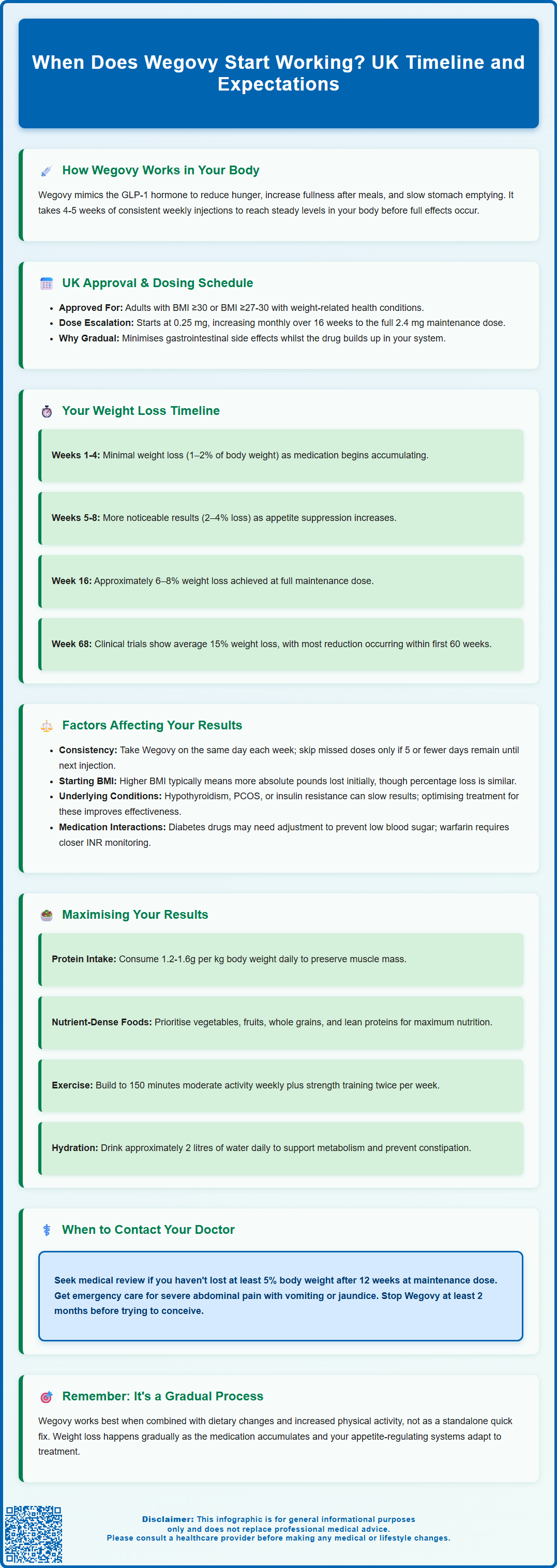Wegovy®
A weekly GLP-1 treatment proven to reduce hunger and support meaningful, long-term fat loss.
- ~16.9% average body weight loss
- Boosts metabolic & cardiovascular health
- Proven, long-established safety profile
- Weekly injection, easy to use

Wegovy (semaglutide 2.4 mg) is a once-weekly injection licensed in the UK for weight management in adults with obesity or overweight with comorbidities. Many patients wonder when does Wegovy start working and when they'll notice results. The medication doesn't produce instant weight loss; instead, it works gradually as it accumulates in your system over several weeks. Most people begin noticing appetite changes within the first month, with measurable weight loss typically becoming apparent by weeks 5–8. Understanding this timeline helps set realistic expectations and supports adherence to the structured dose-escalation schedule recommended by NICE guidance.
Summary: Wegovy typically begins working within the first 4 weeks with subtle appetite changes, whilst measurable weight loss usually becomes apparent by weeks 5–8 as doses increase.
Wegovy (semaglutide 2.4 mg) is a glucagon-like peptide-1 (GLP-1) receptor agonist licensed in the UK as an adjunct to a reduced-calorie diet and increased physical activity for weight management in adults with an initial BMI of ≥30 kg/m² (obesity) or ≥27 kg/m² to <30 kg/m² (overweight) in the presence of at least one weight-related comorbidity. Understanding its mechanism of action helps explain the timeline for seeing results.
Semaglutide mimics the naturally occurring hormone GLP-1, which is released from the intestine after eating. It works through several complementary pathways:
Appetite regulation: Wegovy acts on receptors in the brain's appetite centres (particularly the hypothalamus), reducing hunger signals and increasing feelings of fullness after meals
Gastric emptying: The medication slows the rate at which food leaves your stomach, prolonging satiety and reducing the desire to eat between meals
Blood glucose control: It enhances insulin secretion when blood glucose levels are elevated and suppresses inappropriate glucagon release, which can indirectly support weight management
Once injected subcutaneously, semaglutide is absorbed gradually into the bloodstream. The medication has a long half-life of approximately one week, which is why it's administered as a once-weekly injection. This extended half-life means the drug accumulates in your system over several weeks before reaching steady-state concentrations—typically after 4–5 weeks of consistent dosing.
It's important to understand that Wegovy doesn't work instantaneously. The physiological changes occur progressively as the medication builds up in your body and your appetite-regulating systems adjust to the treatment. This gradual approach also helps minimise gastrointestinal side effects, which is why the dosing schedule starts low and increases incrementally over several months.

The initial phase of Wegovy treatment follows a carefully structured dose-escalation schedule, designed to improve tolerability whilst allowing your body to adapt to the medication. Understanding this timeline helps set realistic expectations about when you'll notice changes.
Weeks 1–4 (0.25 mg dose): During the first month, you're on the lowest starter dose. Many patients report subtle changes in appetite—perhaps feeling satisfied with smaller portions or experiencing fewer cravings between meals. However, significant weight loss is uncommon at this stage. Some individuals may notice mild gastrointestinal effects such as nausea, which typically improves as your body adjusts. Weight loss during this period averages approximately 1–2% of body weight in clinical trials, though individual responses vary considerably.
Weeks 5–8 (0.5 mg dose): As the dose increases, appetite suppression often becomes more noticeable. You may find yourself naturally eating less without feeling deprived. Weight loss typically becomes more apparent, with many patients losing approximately 2–4% of their starting weight by the end of this phase, based on clinical trial data.
Weeks 9–16 (escalating to 1.7 mg): The dose continues to increase monthly (0.5 mg → 1 mg → 1.7 mg). During this period, most patients experience consistent, gradual weight loss. Clinical trials show that by week 16, average weight loss reaches approximately 6–8% of baseline body weight.
Week 17 onwards (2.4 mg maintenance dose): You'll reach the full therapeutic dose, where the medication's effects are most pronounced. Weight loss continues progressively over the following months. In the pivotal STEP trials, patients achieved an average of 15% weight loss at 68 weeks, with most weight reduction occurring within the first 60 weeks of treatment. Note that results may be lower in people with type 2 diabetes or in real-world settings.
It's essential to remember that Wegovy is not a quick fix. The medication works best as part of a comprehensive approach including dietary modifications and increased physical activity. In the UK, Wegovy is typically prescribed through specialist weight management services according to NICE guidance (TA875).
Individual responses to Wegovy vary significantly, and several factors influence both the speed and magnitude of weight loss. Understanding these variables can help you set realistic expectations and identify potential barriers to success.
Starting weight and body composition: People with higher baseline BMI often experience more rapid initial weight loss in absolute terms, though percentage weight loss may be similar across BMI categories. Body composition also matters—individuals with more metabolic dysfunction may respond differently than those with primarily dietary-driven weight gain.
Adherence to the dosing schedule: Consistency is crucial. Missing doses or delaying dose escalation can slow progress. The medication must be taken weekly on the same day to maintain steady blood levels. If you miss a dose and it's 5 days or less until your next scheduled dose, skip the missed dose. If more than 5 days remain, take the missed dose as soon as possible.
Concurrent medications: Certain medications may influence Wegovy's effectiveness or tolerability:
Diabetes medications: If you're taking insulin or sulfonylureas, dose adjustments may be needed to prevent hypoglycaemia
Medications affecting gastric emptying: Drugs that also slow digestion may intensify gastrointestinal side effects
Warfarin: Dietary changes while on Wegovy might affect INR levels; additional monitoring may be needed
Metabolic and hormonal factors: Conditions such as hypothyroidism, polycystic ovary syndrome (PCOS), or insulin resistance can affect weight loss speed. Ensuring these conditions are optimally managed improves outcomes. Additionally, previous weight loss attempts and metabolic adaptation (where your body becomes more efficient at conserving energy) may influence initial response rates.
Gastrointestinal tolerance: Some patients experience significant nausea or other side effects that limit their ability to escalate doses as scheduled. Working with your prescriber to manage these symptoms—through anti-emetics, dietary adjustments, or temporarily maintaining a lower dose—can help you continue treatment effectively.
Genetic factors: Emerging research suggests genetic variations in GLP-1 receptor expression and function may influence individual responses, though this isn't currently used for clinical decision-making.
Pregnancy planning: Wegovy is contraindicated during pregnancy and should be discontinued at least 2 months before a planned pregnancy. It is also not recommended during breastfeeding.
Wegovy is most effective when combined with evidence-based lifestyle modifications. The medication facilitates weight loss by reducing appetite, but your dietary choices and activity levels significantly influence the speed and sustainability of results.
Nutritional strategies to enhance Wegovy's effects:
Prioritise protein intake: Many weight management programmes suggest 1.2–1.6 g per kilogram of body weight daily, though this should be personalised, particularly if you have kidney disease. Adequate protein helps preserve lean muscle mass during weight loss and enhances satiety, working synergistically with Wegovy's appetite-suppressing effects
Focus on nutrient density: Because you'll naturally eat less, every bite should count nutritionally. Emphasise vegetables, fruits, whole grains, lean proteins, and healthy fats whilst limiting ultra-processed foods
Manage portion sizes mindfully: Wegovy reduces appetite, but eating too quickly or ignoring fullness cues can still cause discomfort. Eat slowly, chew thoroughly, and stop when comfortably satisfied
Stay hydrated: Adequate fluid intake (approximately 2 litres daily for most people, but this should be individualised if you have heart or kidney conditions) supports metabolism and helps distinguish true hunger from thirst. It also helps manage potential constipation, a common side effect
Time your meals strategically: Some patients find eating smaller, more frequent meals reduces nausea, whilst others prefer three structured meals. Experiment to find what works best for you
Physical activity recommendations: UK Chief Medical Officers' guidelines recommend adults should aim for at least 150 minutes of moderate-intensity activity or 75 minutes of vigorous activity weekly, plus strength activities on at least 2 days per week. Start gradually if you're currently inactive:
Weeks 1–4: Focus on establishing a walking routine—even 10–15 minutes daily
Weeks 5–12: Gradually increase duration and intensity; consider adding resistance training twice weekly to preserve muscle mass
Beyond 12 weeks: Aim for a balanced programme including cardiovascular exercise, strength training, and flexibility work
Behavioural strategies: Keep a food and symptom diary to identify patterns between eating habits and how you feel. This can help you optimise meal timing and composition. Consider working with a registered dietitian who can provide personalised guidance aligned with your medical history and weight loss goals.
When to seek medical advice: Contact your healthcare provider if you're not losing at least 5% of your starting weight after 12 weeks at the maintenance dose, as treatment continuation should be reviewed. Seek urgent medical attention (call 999 or go to A&E) if you experience severe abdominal pain, especially with vomiting or radiating to your back (possible pancreatitis), or if you develop right upper abdominal pain with yellowing of the skin/eyes (possible gallstones). Report any suspected side effects via the MHRA Yellow Card Scheme.
Most patients notice subtle appetite changes within the first 4 weeks on the starter dose, with measurable weight loss typically becoming apparent by weeks 5–8 as the dose increases. Significant weight loss continues progressively, with clinical trials showing an average of 6–8% weight reduction by week 16 and approximately 15% at 68 weeks on the full maintenance dose.
Wegovy has a long half-life of approximately one week, meaning it accumulates gradually in your system over 4–5 weeks before reaching steady-state concentrations. The structured dose-escalation schedule also allows your body to adapt to the medication whilst minimising gastrointestinal side effects, ensuring both safety and tolerability.
If you haven't lost at least 5% of your starting weight after 12 weeks at the 2.4 mg maintenance dose, contact your healthcare provider to review your treatment. Factors such as adherence to the dosing schedule, dietary habits, concurrent medications, and underlying metabolic conditions can all influence response and may need adjustment.
The health-related content published on this site is based on credible scientific sources and is periodically reviewed to ensure accuracy and relevance. Although we aim to reflect the most current medical knowledge, the material is meant for general education and awareness only.
The information on this site is not a substitute for professional medical advice. For any health concerns, please speak with a qualified medical professional. By using this information, you acknowledge responsibility for any decisions made and understand we are not liable for any consequences that may result.
Lorem ipsum dolor sit amet, consectetur adipiscing elit, sed do eiusmod tempor incididunt ut labore et dolore magna aliqua. Ut enim ad minim veniam, quis nostrud exercitation ullamco laboris nisi ut aliquip ex ea commodo consequat. Duis aute irure dolor in reprehenderit in voluptate velit esse cillum dolore eu fugiat nulla pariatur.
Block quote
Ordered list
Unordered list
Bold text
Emphasis
Superscript
Subscript